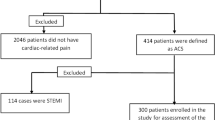Abstract
Objective
Recently, a new traditional Chinese medicine differentiation theory “Syndrome Element (SE)” has been raised. In this study, the main syndrome element types and their correlations with the results of coronary angiography (CAG) in patients with coronary heart disease (CHD) were investigated.
Methods
Epidemiology cross-sectional study method was employed and 324 patients with CHD were enrolled, and their syndrome element types as well as the CAG results were analyzed. The correlations among syndrome element types, Gensini score, and the number of abnormal branches were also analyzed based on the distribution characteristics of syndrome element and coronary angiography results in the 324 cases.
Results
According to their occurrence frequency in 324 CHD patients, the top eight major heart syndrome elements were Xin (心) blood stasis (85.8%), Xin qi deficiency (79.6%), Xin heat blockage (41.1%), Xin phlegm with turbid fluid (38.0%), Xin qi stagnation (24.7%), Xin yang deficiency (18.9%), Xin yin deficiency (17.5%) and Xin cold coagulation (4.4%), respectively, which suggested that Xin blood stasis and Xin qi deficiency were the two most common syndrome elements. Also, as coronary artery Gensini score increased, the changing trend of the syndrome element was “Xin yang deficiency with blood stasis” to “Xin phlegm obstruction with heat blockage” to “Xin yin deficiency with blood stasis” to “Xin qi deficiency with blood stasis” to “Xin cold coagulation with phlegm and turbid fluid, “Xin cold coagulation with blood stasis” to “Xin deficiency of qi, yin and yang”. As the number of abnormal branches increased, the syndrome element changing trend was “simultaneous occurrence of cold and heat syndrome” to “Xin qi and yang deficiency with blood stasis” to “Xin retention of phlegm with turbid fluid” to “Xin cold coagulation in the heart meridian”, “Xin deficiency of both qi and yin”. The result of this study shows that Xin qi deficiency and Xin blood stasis were the major syndrome elements in patients with CHD.
Conclusion
As the severity and extent of coronary artery lesion increased, there were some apparent correlations among syndrome elements, Gensini score and number of abnormal coronary artery branches.
Similar content being viewed by others

References
Dixon SR, Grines CL, O’Neill WW. The year in interventional cardiology. J Am Coll Cardiol 2006;47:1689–1706.
Zhang ZB, Wang YY. Establishment of a new TCM syndrome differentiation system. J Beijing Univ Tradit Chin Med (Chin) 2005;28(1):2–3.
Zhu WF. Standardization research of differentiation system of symptoms and signs and “syndrome” in TCM. Tianjin J Tradit Chin Med 2002;19(5):1–3.
Zhang ZB, Wang YY, Lv AP, et al. On combined syndrome differentiation of essential elements of syndrome and syndrome target point correspondeing syndromes. J Tradit Chin Med (Chin) 2006;47(7):483–485.
Tian DH. Analysis of syndrome elements in TCM. J Shandong Univ Tradit Chin Med (Chin) 1998;22(2):87–88.
ACC/AHA. Guidelines for the management of patients with stable agina. Clinic Focus (Chin) 2004;19(3):124–127.
Cardiovasclar Subcommittee, Chinese Medical Association (CSCMA), Editorial Board of The Chinese Journal of Cardiology. Advice for the diagnosis and management of patients with unstable angina pectoris. Chin J Cardiol (Chin) 2000;28(6):409–412.
Tentative Standard Approved by National Acdemic Seminar (NAS) on TCM Syndrome-Differentiation-Based Treatment of Coronary Artery Disease. J Tradit Chin Med (Chin) 1980;21(8):46.
Gensini GG. Coronary arterography. In: Braunwald E ed. Heart disease, a text book of cardiovascular. London: W.B. Saunders CO, 1984:304.
Wang Y, Zhang W, Hui R, et al. VKORC1 haplotypes are associated with arterial vascular disease (stroke, coronary heart disease, and aortic dissection). Circulation 2006;113:1615–1621.
Chen KJ, Song J. Clinical study by way of combining diseases with differentiation of their syndromes, an important mode in studying on combination of Chinese traditional and Western medicine. World Sci Technol/Modernization Tradit Chin Med Materia Med (Chin) 2006;8(2):1–2.
Wang YY, Zhang QM, Zhang ZB. The induction of syndrome factor and affecting target. J Shandong Univ Tradit Chin Med 2006;30(1):6.
Author information
Authors and Affiliations
Corresponding author
Additional information
Supported by Grants from 973 Program of China (No. 2003CB517103)
Rights and permissions
About this article
Cite this article
Wang, J., Chu, Fy., Li, J. et al. Study on syndrome element characteristics and its correlation with coronary angiography in 324 patients with coronary heart disease. Chin. J. Integr. Med. 14, 274–280 (2008). https://doi.org/10.1007/s11655-008-0274-2
Received:
Published:
Issue Date:
DOI: https://doi.org/10.1007/s11655-008-0274-2



